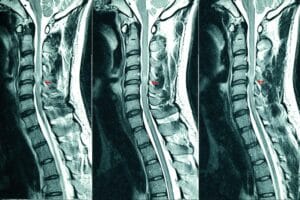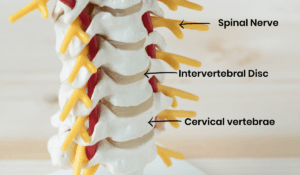Cervical Radiculopathy (‘Trapped Nerve’ in the neck)
Prices are inclusive of assessment, ultrasound scan and ultrasound guided injection
About Cervical Radiculopathy
Cervical radiculopathy, commonly referred to as a “trapped nerve,” occurs when a nerve in the neck becomes compressed, damaged, or irritated as it exits the spinal column. This condition typically results in pain that radiates into the shoulder and arm, and may also cause muscle weakness, numbness, or tingling sensations. While it most often appears on one side of the body (unilateral), in more severe cases can present on both sides (bilateral).
The primary approaches to treating cervical radiculopathy include medication, modifications to daily activities, rehabilitation, and physiotherapy. While a lot of people respond very well to these treatments, sometimes, when these methods do not provide adequate relief, guided spinal injections, such as a cervical nerve root injection may be considered as the best next step.
Nerve pain can be incredibly debilitating; if your symptoms are very severe, and you are not able to sleep or carry out your normal daily activities, then it might be that having a nerve root injection should be considered sooner rather than later.
At Complete injections we offer ultrasound-guided spinal injections that are affordable and easy to access. You can book your appointment directly without needing a referral, allowing for quick and straightforward pain relief treatment for neck and arm pain.
This page provides key information on:
- The anatomy of the cervical spine and how radiculopathy occurs.
- Common causes and risk factors of cervical radiculopathy.
- Recognising the signs and symptoms.
- How this condition is diagnosed.
- Treatment options available to help you recover, including guided spinal injections
Anatomy of the Cervical Spine and Radiculopathy
The spine is a complex bony structure that supports the body and keeps us upright. It consists of 24 vertebral bones, with the first seven of these bones forming the cervical spine (the neck). These bones are separated by intervertebral discs, which act as shock absorbers to protect the neck joints and prevent the vertebral bones from being damaged. They also help reduce vibrations from higher impact activities like jumping and running travelling up to your skull and brain.
The cervical spine is highly flexible, allowing for a wide range of head and neck movements, but this flexibility also makes it more vulnerable to injury.
Spinal nerves exit the spinal cord through openings between the vertebrae (the foramen), and when these nerves are compressed or irritated, the condition called cervical radiculopathy can develop. There are eight pairs of cervical nerve roots (C1-C8), which control movement and sensation in the shoulders, arms, hands, and fingers.
When your spinal specialist is assessing your neck pain, they will be able to palpate the levels of your cervical spine and accurately diagnose the level of spinal nerve that is being affected. This will ensure that your physiotherapy or spinal injection is targeted to the exact area that is causing your pain.
Causes of Cervical Radiculopathy
Cervical radiculopathy is typically caused by structural changes or damage around the nerve roots. These changes can involve bones, intervertebral discs, ligaments, or tendons.
The primary causes include:
- Herniated Discs (Disc bulge/prolapse): Over time, the spinal discs can wear down (degenerative disc disease), becoming prone to bulging or herniation. A herniated disc occurs when this soft disc between vertebrae pushes out, pressing on a nerve root. This pressure on the nerve is what causes pain, numbness, and weakness in the upper arm.
- Bone Spurs: As we age, joint cartilage in the spine is subjected to wear and tear, leading to increased stress on the bones. This can result in bone spurs forming around the facet joints (add link to cervical facet joint pain) and foramen, which compress the nerves and trigger symptoms of nerve entrapment/irritation.
Other, less common causes include:
- Spinal trauma such as a whiplash injury or traumatic disc herniation
- Thickening of spinal ligaments.
- Tumours or growths in the spine.
- Infections causing nerve inflammation.
Who is at risk from developing cervical radiculopathy?
Cervical radiculopathy can affect anyone but is most common in older adults:
- Younger individuals (20s/30s): More likely to experience radiculopathy due to injuries or trauma from sports or accidents.
- Middle-aged adults (50s/60s): More commonly affected by degenerative changes, such as herniated discs or bone spurs.
- Older adults (60+): Joint changes, osteoarthritis, and bone spurs become more common causes of radiculopathy in this age group.
At Complete Injections, we treat you as an individual, understanding that each person’s needs are unique. We have experience working with a diverse range of patients, from elderly individuals wanting to walk to the shops to Olympic athletes seeking peak performance. Whatever your goals may be, we are here to help you achieve them and support your full recovery.
Symptoms of Cervical Radiculopathy
The primary symptom of cervical radiculopathy is neck pain that radiates into the arm, chest, shoulders, or upper back. Often, the neck pain is less severe than the pain felt in the arm or shoulder. Other common symptoms include:
- Tingling or “pins and needles” in the fingers or hand.
- Muscle weakness in the arm, shoulder, or hand, which may manifest as a weak grip or difficulty holding objects.
- Numbness in the arm or hand.
- Muscle spasms or tightness.
- Headaches, particularly at the back of the head.
Symptoms typically develop gradually and may come and go, worsening with certain activities. As the condition progresses, episodes can become more frequent and severe.
Diagnosis of Cervical Radiculopathy
Subjective History
A diagnosis begins with taking a detailed medical history and a discussion on your symptoms and how/when they started.
You will be asked questions about your pain, triggers, and lifestyle that will help your physiotherapist form a clear picture of your condition before conducting a physical examination.
Clinical Examination
Your spinal clinician will then carry out a physical examination to assess:
- Range of movement in the neck and shoulders.
- Muscle strength in the neck, arms, and hands.
- Sensory responses and reflexes in the upper limbs.
- Spinal posture and stability.
- Muscle tension and tightness.
Imaging Studies
Imaging, such as X-rays or MRIs, may be ordered if necessary:
- X-rays: Useful for assessing bone structure, fractures, degeneration, or bone spurs.
- MRI: Provides detailed images of the spinal cord, nerves, and discs to identify nerve compression or herniated discs.

Please note that if you are having a spinal injection, then you will need to have an up to date MRI scan that has been done within the last 6 months. We can help arrange these for you if they are required.
- Diagnostic Ultrasound: For diagnosing cervical radiculopathy, MRI and CT scans are typically preferred as they provide detailed images of the spine, nerves, and surrounding structures. However Ultrasound allows for real-time, dynamic imaging, enabling clinicians to assess nerve mobility and muscle function during specific movements. This can help differentiate between radicular pain originating from the cervical spine and other causes of neck or arm pain.
While ultrasound is not a definitive diagnostic tool for cervical radiculopathy, it can complement other diagnostic methods, particularly for assessing soft tissue changes and guiding treatment such as spinal injections.
Treatment Options for Cervical Radiculopathy
At Complete Injections, we focus on helping patients manage pain, restore movement, and reduce the risk of recurrence. The first line of treatment will always be a course of physiotherapy, however if your symptoms are very acute and are severely affecting your daily mobility and function, or if you have been suffering for a prolonged period with no significant benefit from physio treatment, or if you are in too much pain to be able to engage in your physiotherapy, then we may suggest that you need a guided spinal injection.
Your physiotherapy treatment plan will be tailored to your specific needs and goals, with a range of techniques that may include:
Physiotherapy Treatment for Radiculopathy
- Pain Management
We aim to reduce your pain and inflammation early on, enabling you to engage in your rehabilitation effectively. Techniques may include acupuncture, ice/heat therapy, soft tissue massage, joint mobilisations, and taping. Our specialists can prescribe medication if necessary, further enhancing your treatment plan. - Manual Physiotherapy
Hands-on treatments such as joint mobilisations or manipulations may relieve pressure in the neck and nerve irritation. Soft tissue massage may also help alleviate muscle tension and spasms. - Movement and Strengthening
As your pain improves, we will focus on activity modification, restoring movement and strengthening muscles with individualised exercise programs targeting your neck, upper back, and arms. This phase prepares you for a safe return to normal activities. - Posture and Ergonomics
Proper posture is crucial to preventing recurrence. We offer ergonomic assessments for your workspace, ensuring long-term protection against future flare-ups. Pilates or posture-focused exercises may also be recommended to support your recovery.
Cervical Spinal Injections for Radiculopathy
For patients whose pain persists despite physiotherapy, cervical spinal injections may provide relief. At Complete Injections, we work with a leading spinal specialist Dr. Matteo Bernardotto, a Consultant in Musculoskeletal Sport and Exercise Medicine, who can administer various types of injections depending on the exact cause of your radiculopathy. These will likely be either a nerve root injection or a facet joint injection, or in some cases both.
A cervical steroid injection involves delivering a powerful anti-inflammatory medication near the affected nerve or joint.
While this does not address the root cause of nerve compression, it reduces inflammation and provides a window of relief, allowing you to engage more effectively in rehabilitation.
After an injection, patients are encouraged to resume physiotherapy within one week to maximise recovery. The pain relief from these injections can last anywhere from a few weeks to several years, depending on the individual.
It is important to note that before undergoing a spinal injection procedure, patients must have an up-to-date MRI scan (within the last 6 months) to ensure an accurate diagnosis and effective treatment. Additionally, patients will be required to fill out a screening form to assess their eligibility for any spinal injection procedure. This helps us ensure your treatment is tailored to your specific needs and ensures the best possible outcomes.
Spinal Injections are available at our Kentish Town Clinic
Spinal Surgery for Cervical Radiculopathy
If conservative treatments and injections do not provide relief, spinal surgery may be considered. Surgery is typically reserved for cases of:
- Severe, unbearable pain.
- Progressive muscle weakness.
- Numbness or muscle wasting.
- Significant interference with daily activities and mental health.
Common surgical procedures include Anterior Cervical Fusion, Artificial Disc Replacement (ADR), or Posterior Cervical Laminoforaminotomy. Post-surgical rehabilitation is critical, and our physiotherapists will work closely with your surgeon to ensure optimal recovery.
Ultrasound Guided Injection
Complete Injections is a highly specialised ultrasound guided injection service created to provide fast access to pain relieving injections for a wide range of musculoskeletal conditions delivered by our team of experts.
Self-referral accepted
We do not need a doctor to refer you
Minimal waits
We can usually see you within 24-48 hours
Excellent self-pay rate
From £230 including assessment, ultrasound guided injection and report
Highly experienced clinicians
We perform hundreds of injections every year
Convenient central London locations
ULTRASOUND GUIDED INJECTION ONE STOP SHOP FEES
- Same Day Consultation (subject to availability).
- Ultrasound scan and musculoskeletal assessment.
- Ultrasound Guided Injection.
- Report of assessment and scan findings and details of injection.
- All included for total fee: £230 cortisone injection, (advanced procedures are £250).
- A comprehensive range of injection procedures for musculoskeletal conditions are offered.
- All injections are performed by highly experienced advanced physiotherapists dual trained as physiotherapist and musculoskeletal sonographer.
- All are qualified as independent prescribers to allow them to screen you for any possible medicines interactions and select the most appropriate medication for your injection.
- All hold full qualifications in diagnostic ultrasound and injection therapy of peripheral musculoskeletal disorders.
Clinical Director
Chris is one of the few physiotherapists in the country to also be a fully trained as a musculoskeletal sonographer and uses diagnostic ultrasound to diagnose muscle, ligament, tendon, joint and nerve problems. He has been using diagnostic ultrasound…
Clinical Director
David is one of the pioneers of physiotherapists performing ultrasound guided injections. With 20 years of clinical experience as a chartered physiotherapist specialising in musculoskeletal care, David is clinical director at Complete Physio Ltd, with…
Injection Therapist
Luke is a highly specialised advanced level physiotherapist with a broad understanding of musculoskeletal health care. He qualified as a Physiotherapist in 2007 and has a wealth of experience working in both the NHS and privately settings.





